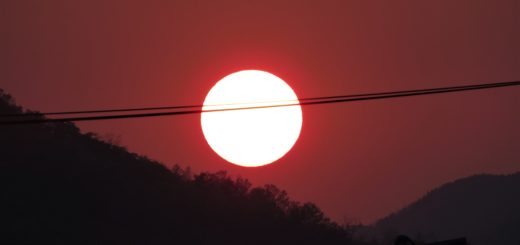Distortions of Proximity
The essence of education is the gradual widening of horizons, which means, most precisely, the extension of one’s view of life, which is necessarily limited at the outset to one’s nearest and most immediate surroundings, to encompass increasingly distant and obscure elements of existence. The widened horizon, in turn, provides a truer context within which to perceive and understand the near and immediate. Without the contextualizing experience of proper education, then, our world is not only narrow, but utterly distorted, as the narrow immediacy persists in our perception in its immature appearance, namely outsized beyond its proper proportion, seriousness, or importance, as things observed without their defining and delimiting context always are.
The favorite songs of our youth necessarily seem like the greatest music of all time until we learn more about the history of music, and our ears become sensitized to more profound musical expression from more emotionally mature times. The movies we loved as young adults inevitably seem earth-shatteringly important, until we deepen our appreciation of classic literature, or even classic film, and thereby begin to recognize the difference between transitory cleverness and timeless human insight. The parents and older siblings we understandably idolize during our childhood will almost certainly shrink back to human proportions as we study history, philosophy, and art, and begin to recognize the greatness that has graced this Earth from time to time.
But the distorting effects of seeing the near and familiar without the needed measure of context are not restricted to the arena of positive assessments of worth and excesses of admiration. Analogous effects are at least as common and inevitable on the negative side of the psychological ledger.
The bogeyman behind the door and the monster under the bed are simply childish flights of imagination exaggerating the natural trepidation that a young mind, lacking experience, feels when faced with the unknown and unseen. The perspective-correcting context, in this case, is mostly a combination of adult reassurance that no such terrors are lurking in the dark and long experience of never actually finding these objects of one’s fear, until the true, unthreatening silence of the darkness supplants the monster world, and its terrifying objects gradually recede into the ancient swamp of childish imagination whence they arose. Context provides a truer perspective.
Rousseau, in his Essay on the Origin of Languages, speculates that the primordial notion of “giants” was most likely a product of the imagination of the earliest men responding to the sight of others of their own race in the distance. Alone, anti-social by physical necessity, struggling for survival, constantly alert to omnipresent dangers, the sight of an unknown man on the next hill would naturally be a source of great fear, and the fear itself, just as with the child’s monster under the bed, would make the stranger appear oversized, larger than life — a “giant.” (Hence, we speak of “shrinking in fear,” an excellent description of the psyche of a frightened man.) Finally, as practical needs draw the men tentatively toward one another, and the initial fear gives way to a faltering sense of sympathy, each learns to see his counterpart in his true proportions, one of his own kind, and the imaginary concept of the giant, forged in response to the fear-induced exaggeration of men’s vision, remains as a useful but vague category of primordial imagery, i.e., it becomes mythology. The tangible truth of one’s environment is restored by the context of experience and practical necessity.
If, on the other hand, fostering and sustaining an irrational fear in others were your goal, then the first and most essential rule of such psychological manipulation becomes clear, in light of what we have just seen: One must obscure the wider context that would reduce the proximate object of terror to its true proportions, thereby encouraging its growth to monstrous proportions in the imagination. In other words, since the answer to irrational fear, as with all spiritual weakness, is education in the broadest sense, the chief means to cultivating such weakness is the deprivation of education. We are currently witnessing one of the most successful applications of this strategy, on a worldwide scale. Since we are all seeing this manipulation, and feeling its force in our own lives on a daily basis, a simple example will more than suffice to make the point.
This week, thanks to a lowered social distancing “level” from the Korean government, I, along with many of my colleagues, began teaching face-to-face classes (i.e., proper classes) for the first time in this fall semester (which is now in its ninth week), which in practice means the first time since last December, given that my university imposed full online education throughout the spring semester as well. I was eager to bring the students back as soon as possible for various reasons, of course, but no reason was more compelling in my mind than the knowledge that after so many months of online education and relentless COVID propaganda, a significant proportion of the student body is becoming comfortable with this arrangement, and reluctant to return to normal classes, if not downright averse to it. In short, a certain percentage of students have simply become sanguine about the reality of studying (inadequately) from home, thus enjoying the freedom to putter and play through the semester, without all the “trouble” of having to turn off their social media devices and focus fully on a live human being for an hour. But, as I have learned this week, there is a substantial percentage of students who do not wish to return to class because they are sincerely terrified of “the virus,” and petrified by the “danger” of being around so many of their fellow humans on buses and in classrooms. In short, many students are shrinking in fear — creating giants — as they have been propagandized into doing this year by their government and mass media, not to mention the non-stop input of the hyperbolic and fact-free social media that modern youth have adopted as their reality substitute.
The Korean government, which has been extremely aggressive in testing and tracking virus cases, has officially declared four hundred and sixty-two COVID deaths in the country this year, as of this writing. Yes, I said 462. New cases, nationwide, rarely reach triple digits these days, and most of the new cases are inevitably in seniors homes. The death total, at this point, usually creeps up by about one or two per day, at most. And yet each new positive test in any city is reported by the media, and highlighted by the government, as a dire threat and cause for extreme alarm. And so most Koreans, including and especially the young and inexperienced (remember where the all-important context comes from), take the alarmism at face value, rather than stepping back to view these news reports, and the constant smartphone alerts from their friendly socialist government, in the broader light of everything else.
This week’s newly reported cases here in town, a single digit number, have been cited to me personally by students begging me to return to online classes so they can study in safety — as though ten or fifteen cases (not deaths, but merely positive tests) of a respiratory virus among a local population of roughly a million citizens indicated a grave danger. Meanwhile, that national death total, 462, continues to be the banner headline throughout the Korean media, thereby giving the number a cataclysmic aura — by highlighting it without any context.
This year, the new coronavirus has claimed the lives of 462 people in Korea, a number that feels terrifying to so many people here, simply because it is the only health-related number anyone in the media or government wishes to talk about right now. Let us provide a little context.
In an average year, the normal flu claims the lives of approximately 2,900 Koreans.
In 2019, over 3,300 Koreans died in traffic accidents.
In 2019, 26,000 Koreans died of heart disease.
In 2019, almost 80,000 Koreans died of cancer.
And this one, which for me is the most bracing, and my most urgent argument for ending this context-free propaganda era and encouraging Koreans to reclaim their lives as soon as possible: In 2019, over 13,000 Koreans committed suicide. This year, the number will be much higher. You may easily infer the reason. Korea will suffer more “excess” deaths by suicide this year than from COVID-19.
Education is context. Context is clarity. Clarity brings understanding. Understanding fosters courage. Courage promotes freedom. Is it any wonder, then, that modern governments and their media allies wish to control and short-circuit education and the dissemination of information?



